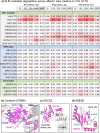Identification of Actionable Targeted Protein Degradation Effector Sites through Site-Specific Ligand Incorporation-Induced Proximity (SLIP)
- PMID: 40493711
- PMCID: PMC12203575
- DOI: 10.1021/jacs.5c01420
Identification of Actionable Targeted Protein Degradation Effector Sites through Site-Specific Ligand Incorporation-Induced Proximity (SLIP)
Abstract
Targeted protein degradation (TPD) is a rapidly emerging and potentially transformative therapeutic modality. However, the large majority of >600 known ubiquitin ligases have yet to be exploited as TPD effectors by proteolysis-targeting chimeras (PROTACs) or molecular glue degraders (MGDs). We report here a chemical-genetic platform, Site-specific Ligand Incorporation-induced Proximity (SLIP), to identify actionable ("PROTACable") sites on any potential effector protein in intact cells. SLIP uses genetic code expansion to encode copper-free "click" ligation at a specific effector site in intact cells, enabling the in situ formation of a covalent PROTAC-effector conjugate against a target protein of interest. Modification at actionable effector sites drives degradation of the targeted protein, establishing the potential of these sites for TPD. Using SLIP, we systematically screened dozens of sites across E3 ligases and E2 enzymes from diverse classes, identifying multiple novel potentially PROTACable effector sites which are competent for TPD. SLIP adds a powerful approach to the proximity-induced pharmacology (PIP) toolbox, enabling future effector ligand discovery to fully enable TPD and other emerging PIP modalities.
Figures






Update of
-
Identification of actionable targeted protein degradation effector sites through Site-specific Ligand Incorporation-induced Proximity (SLIP).bioRxiv [Preprint]. 2025 Feb 4:2025.02.04.636303. doi: 10.1101/2025.02.04.636303. bioRxiv. 2025. Update in: J Am Chem Soc. 2025 Jun 25;147(25):21549-21559. doi: 10.1021/jacs.5c01420. PMID: 39975383 Free PMC article. Updated. Preprint.
References
MeSH terms
Substances
Grants and funding
LinkOut - more resources
Full Text Sources

